HomeMonitor: An Enhanced Device Event Detection Method for Smart Home Environment
Abstract
1. Introduction
- We designed a flow monitoring system called HomeMonitor to achieve the entire process of device event monitoring. For smart home devices based on OpenWRT and DESEND+ to verify the effectiveness of our proposed method. Our system HomeMonitor is designed and implemented based on real IoT situations, which are valuable in practical applications.
- We presented DESEND+, an enhanced event signature extraction, and detection method. The detection speed is faster than PINBALL [33]. At the same time, it has a wider range of applications than PINGPONG [32] which means it can be applied to both TCP and UDP protocols. Furthermore, we added a device event control function to intercept device events by intercepting critical packets. Machine learning methods based on data flow features for this function are difficult to implement, while statistical methods based on packet features do not focus on this.
2. Background and Motivation
2.1. Threat to Smart Home
2.2. Problem Analysis
2.3. Our Idea
- We use device event signature as the basic method of device event detection.
- Only the size of the packets is collected as a signature element feature, and there is no order between the signature elements, which makes the device event signature robust.
- We use a transport protocol-independent mechanism to handle re-transmitted packets.
- In the detection phase, we use packet matching to complete event detection. The detection calculation consumption is independent of the duration of the data flow, so it has a low calculation consumption.
- We control the critical packets to achieve the control function for device events.
3. HomeMonitor
3.1. Overview of HomeMonitor
3.1.1. Event Signature Extraction and Training Module
3.1.2. Event Signature Detection and Matching Module
3.1.3. Event Control Module
3.2. Event Signature Extraction and Training Module
3.2.1. Packet Capture Framework
3.2.2. Signature Extraction and Training
| Algorithm 1. Event signature extraction |
| INPUT: = { , ,…, } Timestamp file: T = { , ,…, } event_trigger_time # Number of events triggered when collecting data OUTPUT: Event signature 1. get counter_list # counter_list save the pkg len in [Ti,Ti + 10s] 2. # example: counter_list = [[T1][P1.len,PK.len],[T2][][],...] 3. get pkg_occurance_num # pkg_occurance_num saves the number of trigger intervals with B 4. # pkg_occurance_num = [[len:P1.len][num:10],...] 5. for each pkg_num in pkg_occurance_num 6. if pkg.num == event_trigger_time 7. event_signature.key.append(pkg.len) 8. if pkg.num >= event_trigger_time-5 9. event_signature.high.append(pkg.len) 10. endfor 11. for each interval in interval list 12. temp_min = Number of occurrences of elements in set event_signature in interval 13. if temp_min < min 14. event_signature.min = temp 15. endfor 16. for each interval in interval list 17. temp_max_time = The maximum time between two packets in a signature in interval 18. if temp_max_time > max_time 19. event_signature.max_time = max_time 20. endfor |
3.3. Event Signature Detection and Matching Module
3.3.1. Policy Table
3.3.2. Detection
| Algorithm 2. Detection and matching |
| INPUT: = { , ,…, } policy table: F = { , ,…, } OUTPUT: Event_Match 1. for each in do 2. for each in F 3. if .ip == .ip do 4. if L() in .key and L() not in .keylist do 5. .keylist.append(L()) 6. .lastpkt_time = T() 7. endif 8. if L() in .high and L() not in .highlist do 9. .highlist.append(L()) 10. lastpkt = T() 11. endif 12. endif 13. endfor 14. for each in F 15. if L(.keylist) >= L(.key)–fix and L(.highlist) >= L(.key)–high fix do 16. Event_Match [.name].append(.lastpkt_time) 17. clearall F.keylist, F.highlist, F.lastpkt_time 18. break 19. endif 20. endfor 21. for each in F 22. if T()–.lastpkt_time < .max_time 23. clear 24. clear .keylist, .highlist, .lastpkt_time 25. endif 26. endfor |
3.4. Event Control Module
3.4.1. Monitoring Rule
3.4.2. Action Control
4. Evaluation and Implementation
4.1. The Implementation of HomeMonitor
4.1.1. Experimental Environment
4.1.2. Device Event Signature Extraction
4.1.3. Device Event Detection
4.2. The Evaluation of Detection
4.2.1. Evaluation Metrics
4.2.2. Simulation Settings
4.2.3. Accuracy
4.2.4. Time Consumption
4.3. The Experiment of Device Event Control
4.3.1. Device Event Control Experiment
4.3.2. Event Detection Report
5. Related Work
5.1. Device Event Detection
5.2. Device Traffic Monitoring
6. Conclusions and Future Work
Author Contributions
Funding
Institutional Review Board Statement
Informed Consent Statement
Data Availability Statement
Conflicts of Interest
References
- Zhou, W.; Jia, Y.; Yao, Y.; Zhu, L.; Guan, L.; Mao, Y.; Liu, P.; Zhang, Y. Discovering and understanding the security hazards in the interactions between IoT devices, mobile apps, and clouds on smart home platforms. In Proceedings of the 28th USENIX Conference on Security Symposium, Santa Clara, CA, USA, 14–16 August 2019. [Google Scholar]
- Turning an Echo into a Spy Device Only Took Some Clever Coding. Available online: https://www.wired.com/story/amazon-echo-alexa-skill-spying (accessed on 2 May 2021).
- Qiu, J.; Tian, Z.; Du, C.; Zuo, Q.; Su, S.; Fang, B. A survey on access control in the age of internet of things. IEEE Int. Things J. 2020, 7, 4682–4696. [Google Scholar] [CrossRef]
- Shafiq, M.; Tian, Z.; Sun, Y.; Du, X.; Guizani, M. Selection of effective machine learning algorithm and Bot-IoT attacks traffic identification for internet of things in smart city. Future Gener. Comput. Syst. 2020, 107, 433–442. [Google Scholar] [CrossRef]
- Tian, Z.; Luo, C.; Lu, H.; Su, S.; Sun, Y.; Zhang, M. User and entity behavior analysis under urban big data. ACM/IMS Trans. Data Sci. 2020, 1, 1–19. [Google Scholar] [CrossRef]
- Ren, J.; Dubois, D.J.; Choffnes, D.; Mandalari, A.M.; Kolcun, R.; Haddadi, H. Information exposure from consumer IoT devices: A multidimensional, network-informed measurement approach. In Proceedings of the Internet Measurement Conference, Amsterdam, The Netherlands, 21–23 October 2019. [Google Scholar]
- Mazhar, M.H.; Shafiq, Z. Characterizing smart home IoT traffic in the wild. In Proceedings of the 2020 IEEE/ACM Fifth International Conference on Internet-of-Things Design and Implementation (IoTDI), Sydney, NSW, Australia, 21–24 April 2020. [Google Scholar]
- Apthorpe, N.; Reisman, D.; Sundaresan, S.; Narayanan, A.; Feamster, N. Spying on the smart home: Privacy attacks and defenses on encrypted IoT traffic. arXiv 2017, arXiv:1708.05044. [Google Scholar]
- Marchal, S.; Miettinen, M.; Nguyen, T.D.; Sadeghi, A.R.; Asokan, N. Audi: Toward autonomous IoT device-type identification using periodic communication. IEEE J. Sel. Areas Commun 2019, 37, 1402–1412. [Google Scholar] [CrossRef]
- Bezawada, B.; Bachani, M.; Peterson, J.; Shirazi, H.; Ray, I.; Ray, I. Behavioral fingerprinting of IoT devices. In Proceedings of the 2018 Workshop on Attacks and Solutions in Hardware Security, Toronto, ON, Canada, 15–19 October 2018. [Google Scholar]
- Sivanathan, A.; Sherratt, D.; Gharakheili, H.H.; Radford, A.; Wijenayake, C.; Vishwanath, A.; Sivaraman, V. Characterizing and classifying IoT traffic in smart cities and campuses. In Proceedings of the 2017 IEEE Conference on Computer Communications Workshops (INFOCOM WKSHPS), Atlanta, GA, USA, 1–4 May 2017. [Google Scholar]
- Miettinen, M.; Marchal, S.; Hafeez, I.; Asokan, N.; Sadeghi, A.R.; Tarkoma, S. IoT SENTINEL: Automated device-type identification for security enforcement in IoT. In Proceedings of the 2017 IEEE 37th International Conference on Distributed Computing Systems (ICDCS), Atlanta, GA, USA, 5–8 June 2017. [Google Scholar]
- Meidan, Y.; Bohadana, M.; Shabtai, A.; Ochoa, M.; Tippenhauer, N.O.; Guarnizo, J.D.; Elovici, Y. Detection of unauthorized IoT devices using machine learning techniques. arXiv 2017, arXiv:1709.04647. [Google Scholar]
- Santos, M.R.P.; Andrade, R.M.C.; Gomes, D.G.; Callado, A.C. An efficient approach for device identification and traffic classification in IoT ecosystems. In Proceedings of the 2018 IEEE Symposium on Computers and Communications (ISCC), Natal, Brazil, 25–28 June 2018. [Google Scholar]
- Shahid, M.R.; Blanc, G.; Zhang, Z.; Debar, H. IoT devices recognition through network traffic analysis. In Proceedings of the 2018 IEEE International Conference on Big Data (Big Data), Seattle, WA, USA, 10–13 December 2018. [Google Scholar]
- Alshehri, A.; Granley, J.; Yue, C. Attacking and protecting tunneled traffic of smart home devices. In Proceedings of the Tenth ACM Conference on Data and Application Security and Privacy, New Orleans, LA, USA, 16–18 March 2020. [Google Scholar]
- Charyyev, B.; Gunes, M.H. IoT event classification based on network traffic. In Proceedings of the IEEE INFOCOM 2020—IEEE Conference on Computer Communications Workshops (INFOCOM WKSHPS), Toronto, ON, Canada, 6–9 July 2020. [Google Scholar]
- Bai, L.; Yao, L.; Kanhere, S.S.; Wang, X.; Yang, Z. Automatic device classification from network traffic streams of internet of things. In Proceedings of the 2018 IEEE 43rd Conference on Local Computer Networks (LCN), Chicago, IL, USA, 1–4 October 2018. [Google Scholar]
- Dong, S.; Li, Z.; Tang, D.; Chen, J.; Sun, M.; Zhang, K. Your smart home can’t keep a secret: Towards automated fingerprinting of IoT traffic. In Proceedings of the 15th ACM Asia Conference on Computer and Communications Security, Taipei, Taiwan, 5–9 October 2020. [Google Scholar]
- Sivanathan, A.; Gharakheili, H.H.; Loi, F.; Radford, A.; Wijenayake, C.; Vishwanath, A.; Sivaraman, V. Classifying IoT Devices in Smart Environments Using Network Traffic Characteristics. IEEE Trans. Mobile Comput. 2019, 18, 1745–1759. [Google Scholar] [CrossRef]
- Aksoy, A.; Gunes, M.H. Automated IoT Device Identification using Network Traffic. In Proceedings of the ICC 2019—2019 IEEE International Conference on Communications (ICC), Shanghai, China, 20–24 May 2019. [Google Scholar]
- Pashamokhtari, A. PhD forum abstract: Dynamic inference on IoT network traffic using programmable telemetry and machine learning. In Proceedings of the 2020 19th ACM/IEEE International Conference on Information Processing in Sensor Networks (IPSN), Sydney, NSW, Australia, 21–24 April 2020. [Google Scholar]
- Sivanathan, A. IoT behavioral monitoring via network traffic analysis. arXiv 2020, arXiv:2001.10632. [Google Scholar]
- Acar, A.; Fereidooni, H.; Abera, T.; Sikder, A.K.; Miettinen, M.; Aksu, H.; Conti, M.; Sadeghi, A.-R.; Uluagac, S. Peek-a-boo: I see your smart home activities, even encrypted! In Proceedings of the 13th ACM Conference on Security and Privacy in Wireless and Mobile Networks, Linz, Austria, 8–10 July 2020. [Google Scholar]
- Thangavelu, V.; Divakaran, D.M.; Sairam, R.; Bhunia, S.S.; Gurusamy, M. DEFT: A distributed IoT fingerprinting technique. IEEE Internet Things J. 2019, 6, 940–952. [Google Scholar] [CrossRef]
- Ortiz, J.; Crawford, C.; Le, F. DeviceMien: Network device behavior modeling for identifying unknown IoT devices. In Proceedings of the International Conference on Internet of Things Design and Implementation, Montreal, QC, Canada, 15–18 April 2019. [Google Scholar]
- OConnor, T.; Mohamed, R.; Miettinen, M.; Enck, W.; Reaves, B.; Sadeghi, A.-R. HomeSnitch: Behavior transparency and control for smart home IoT devices. In Proceedings of the 12th Conference on Security and Privacy in Wireless and Mobile Networks, Miami, Florida, 15–17 May 2019. [Google Scholar]
- Apthorpe, N.; Reisman, D.; Feamster, N. A smart home is no castle: Privacy vulnerabilities of encrypted IoT traffic. arXiv 2017, arXiv:1705.06805. [Google Scholar]
- Sivanathan, A.; Gharakheili, H.H.; Sivaraman, V. Can we classify an IoT device using TCP port scan? In , , In Proceedings of the 2018 IEEE International Conference on Information and Automation for Sustainability (ICIAfS), Colombo, Sri Lanka, 21–22 December 2018. [Google Scholar]
- Valdez, E.; Pendarakis, D.; Jamjoom, H. How to discover IoT devices when network traffic is encrypted. In Proceedings of the 2019 IEEE International Congress on Internet of Things (ICIOT), Milan, Italy, 8–13 July 2019. [Google Scholar]
- Copos, B.; Levitt, K.; Bishop, M.; Rowe, J. Is anybody home? Inferring activity from smart home network traffic. In Proceedings of the 2016 IEEE Security and Privacy Workshops (SPW), San Jose, CA, USA, 22–26 May 2016. [Google Scholar]
- Trimananda, R.; Varmarken, J.; Markopoulou, A.; Demsky, B. Packet-level signatures for smart home devices. In Proceedings of the Network and Distributed System Security Symposium, San Diego, CA, USA, 23–26 February 2020. [Google Scholar]
- Duan, C.; Zhang, S.; Yang, J.; Wang, Z.; Yang, Y.; Li, J. PINBALL: Universal and robust signature extraction for smart home devices. In Proceedings of the 2021 IFIP/IEEE International Symposium on Integrated Network Management (IM), Bordeaux, France, 17–21 May 2021. [Google Scholar]
- FingerBank—Open DHCP Fingerprints Database. Available online: https://www.fingerbank.org/ (accessed on 8 February 2021).
- Charyyev, B.; Gunes, M.H. IoT traffic flow identification using locality sensitive hashes. In Proceedings of the ICC 2020—2020 IEEE International Conference on Communications (ICC), Dublin, Ireland, 7–11 June 2020. [Google Scholar]
- Chen, J.; Liu, Y.; Zhang, S.; Guo, Z.; Chen, B.; Han, Z. DESEND: A Fast Device Event Signature Extraction and Detection Method for Smart Home. In Proceedings of the 2022 7th IEEE International Conference on Data Science in Cyberspace (DSC), Guilin, China, 11–13 July 2022; pp. 646–652. [Google Scholar]
- Lear, E.; Droms, R.; Romascanu, D. Manufacturer Usage Description Specification. Available online: https://www.rfc-editor.org/rfc/rfc8520 (accessed on 8 February 2022).
- Wang, J.; Hao, S.; Wen, R.; Zhang, B.; Zhang, L.; Hu, H.; Lu, R. IoT-Praetor: Undesired behaviors detection for IoT devices. IEEE Internet Things J. 2021, 8, 927–940. [Google Scholar] [CrossRef]
- Chi, H.; Zeng, Q.; Du, X.; Luo, L. PFirewall: Semantics-aware customizable data flow control for home automation systems. arXiv 2019, arXiv:1910.07987. [Google Scholar]
- Xu, R.; Zeng, Q.; Zhu, L.; Chi, H.; Du, X.; Guizani, M. Privacy leakage in smart homes and its mitigation: IFTTT as a case study. IEEE Access 2019, 7, 63457–63471. [Google Scholar] [CrossRef]
- Song, J.; Wang, W.; Gadekallu, T.; Cao, J.; Liu, Y. EPPDA: An Efficient Privacy-Preserving Data Aggregation Federated Learning Scheme. IEEE Trans. Netw. Sci. Eng. 2021. [Google Scholar] [CrossRef]
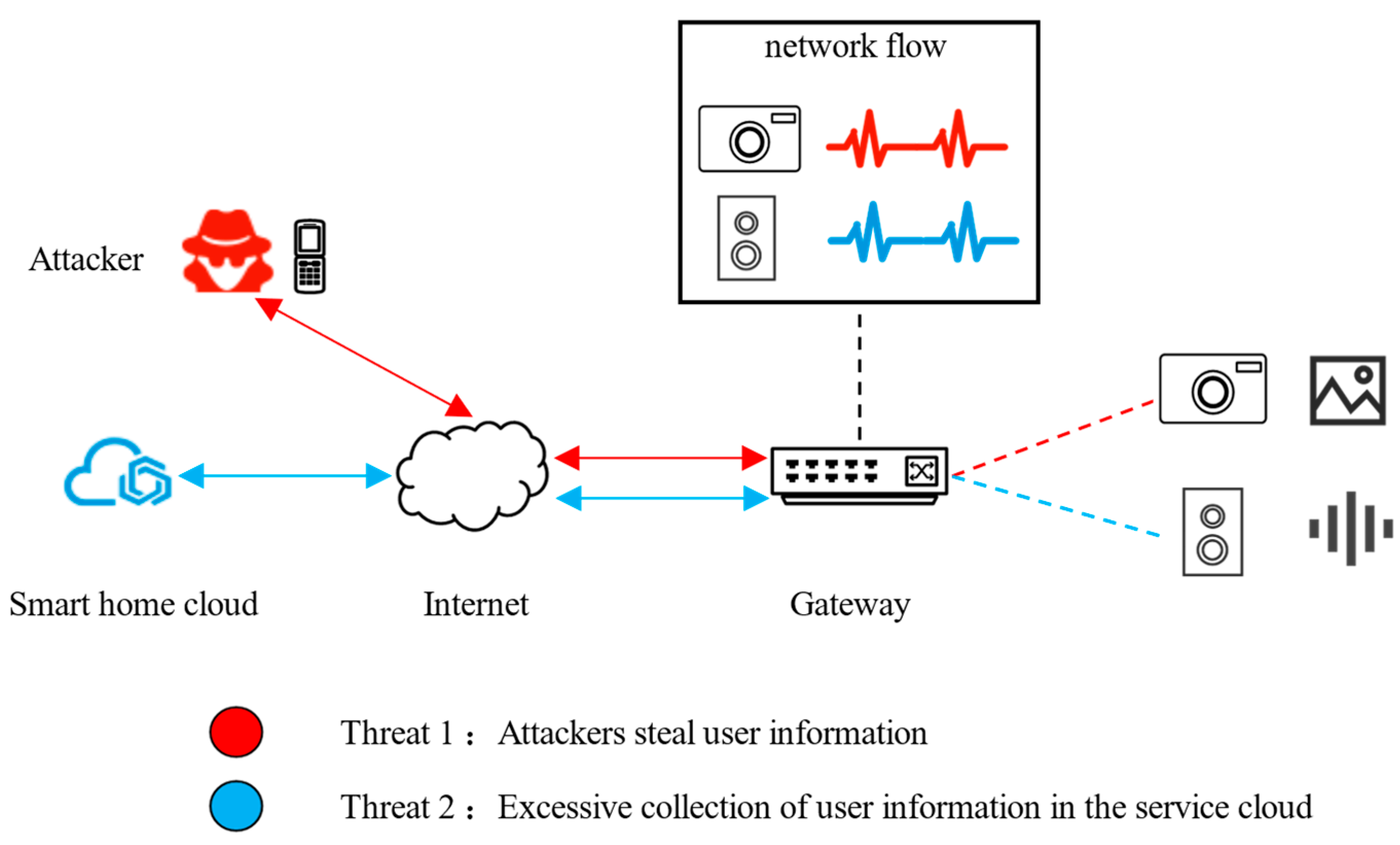
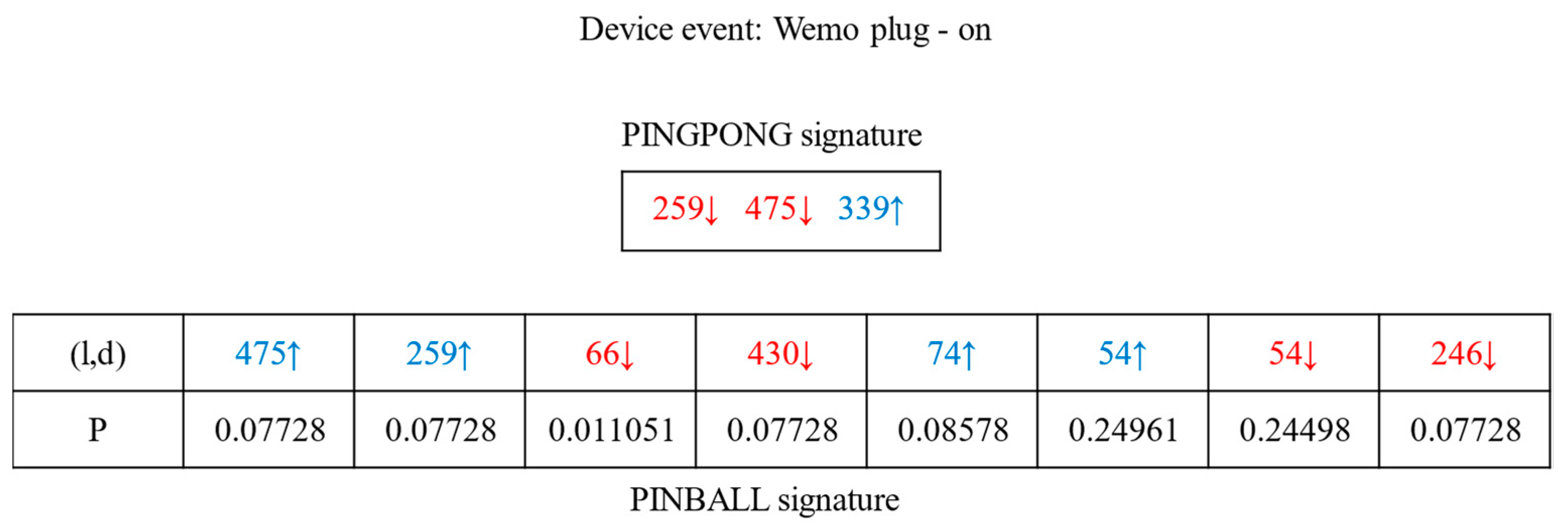
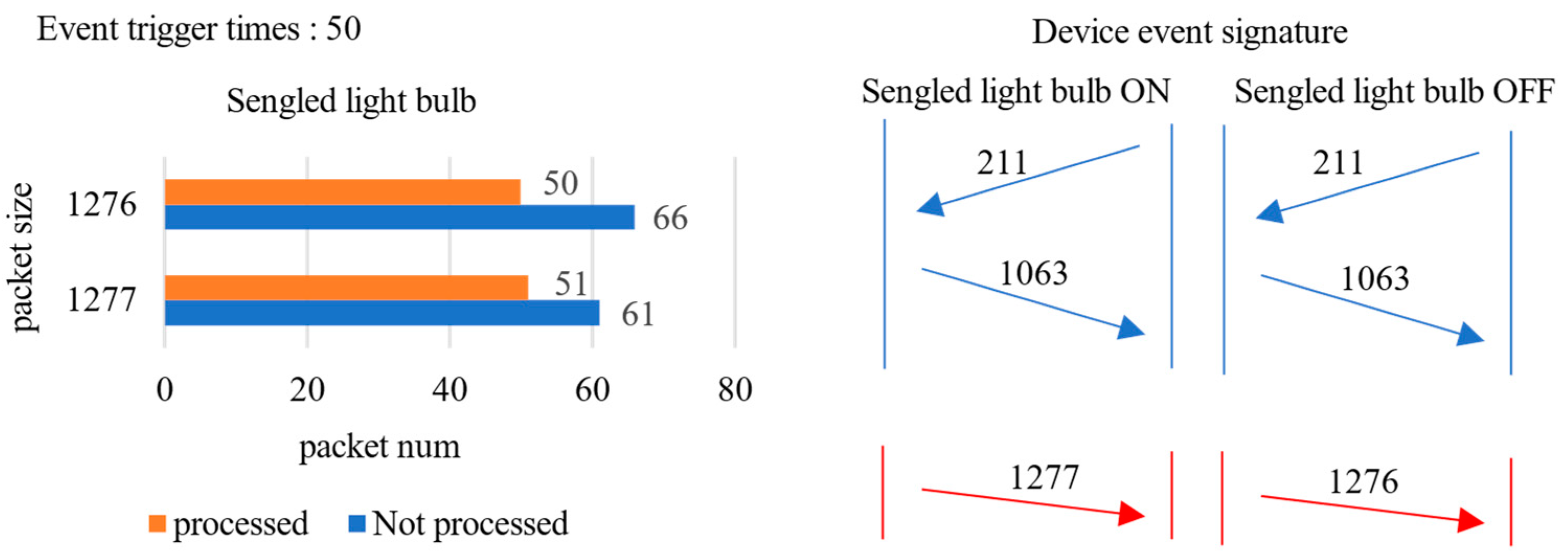
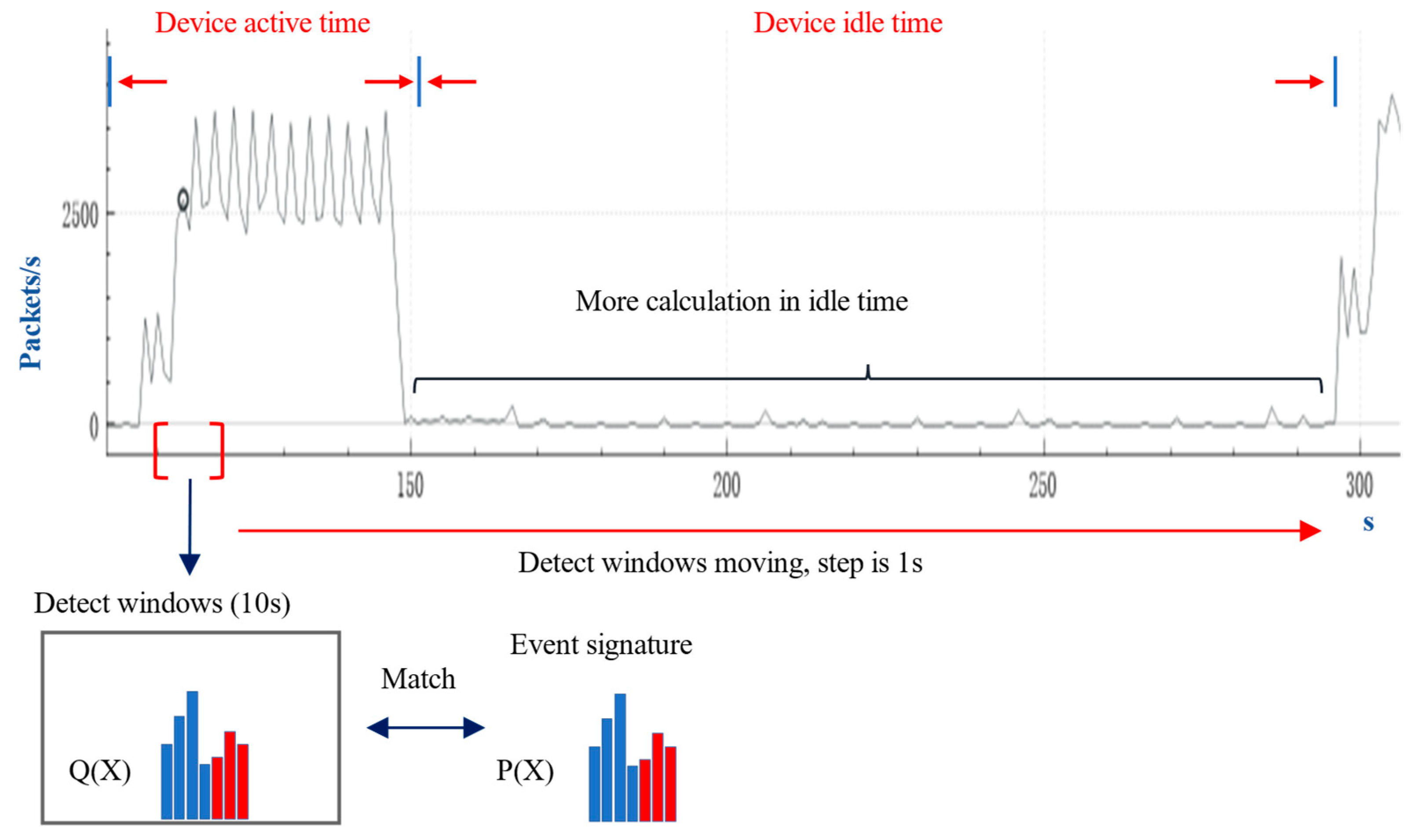
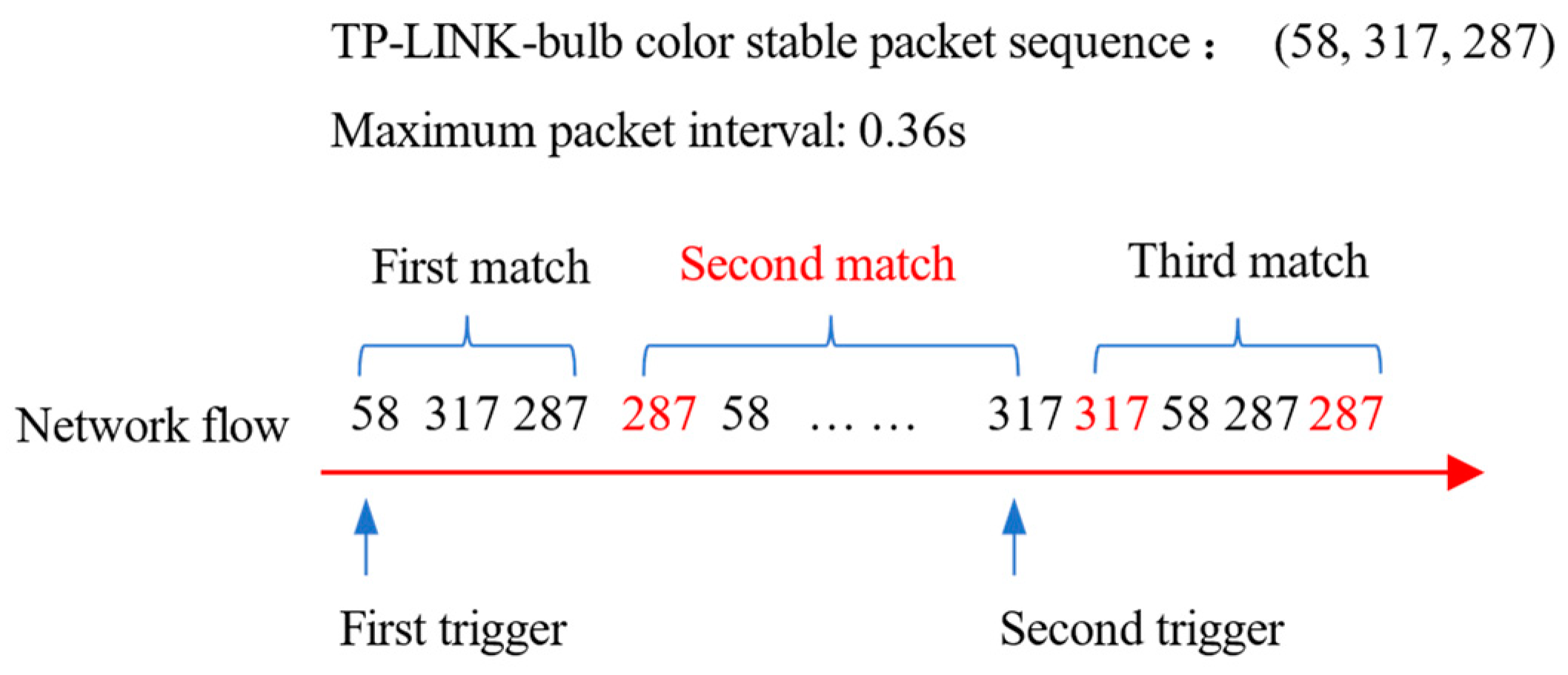
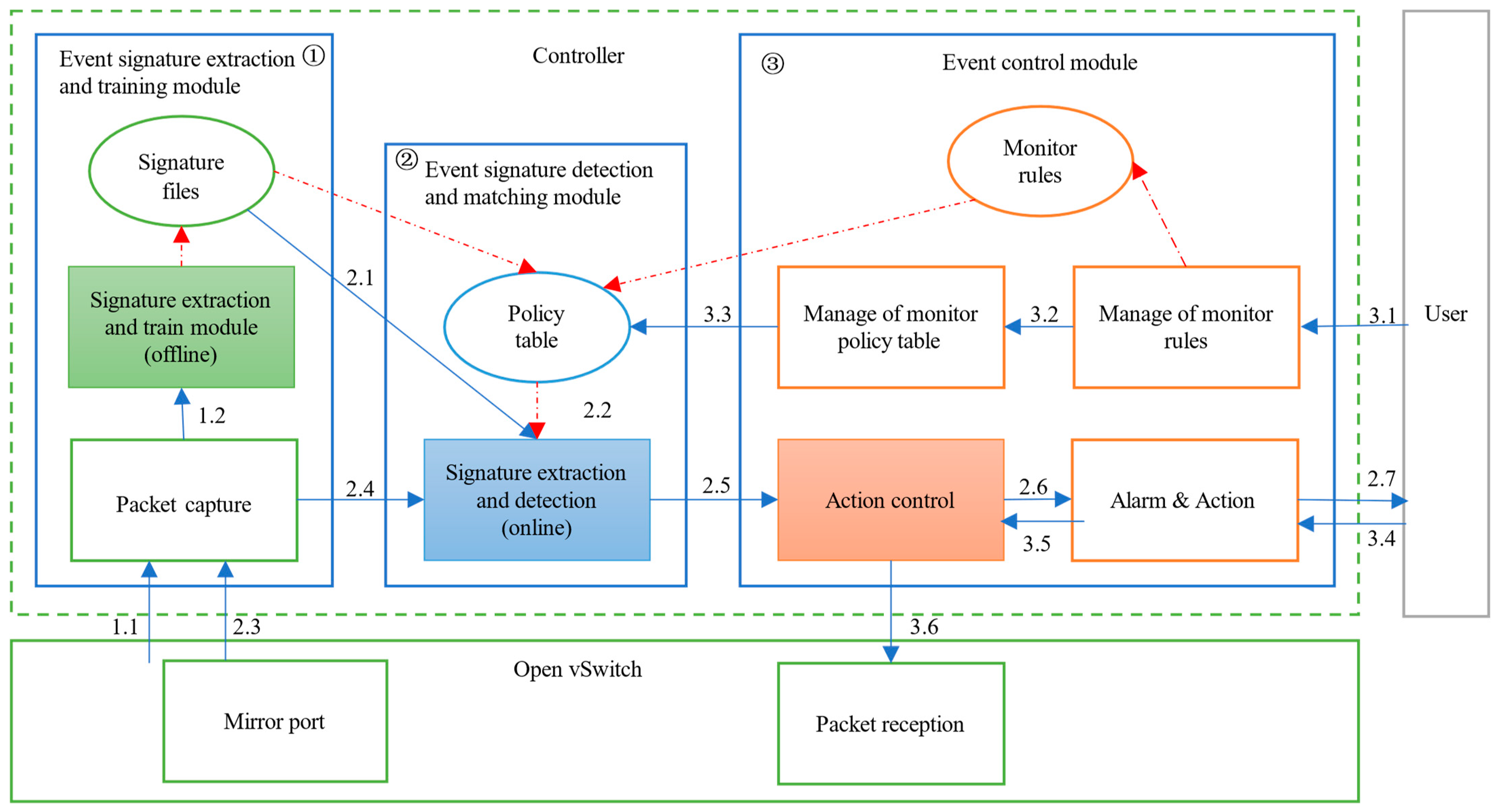
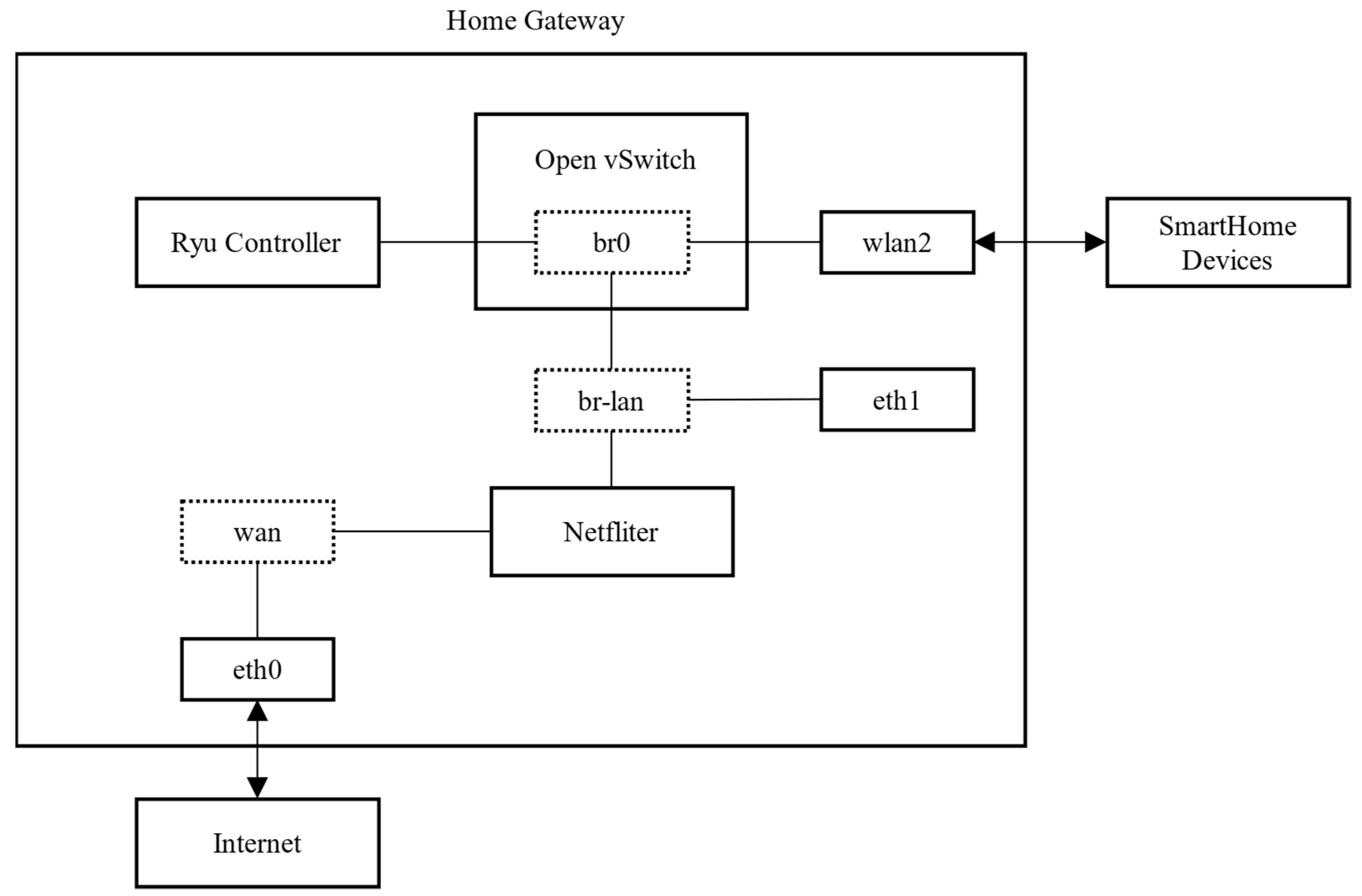

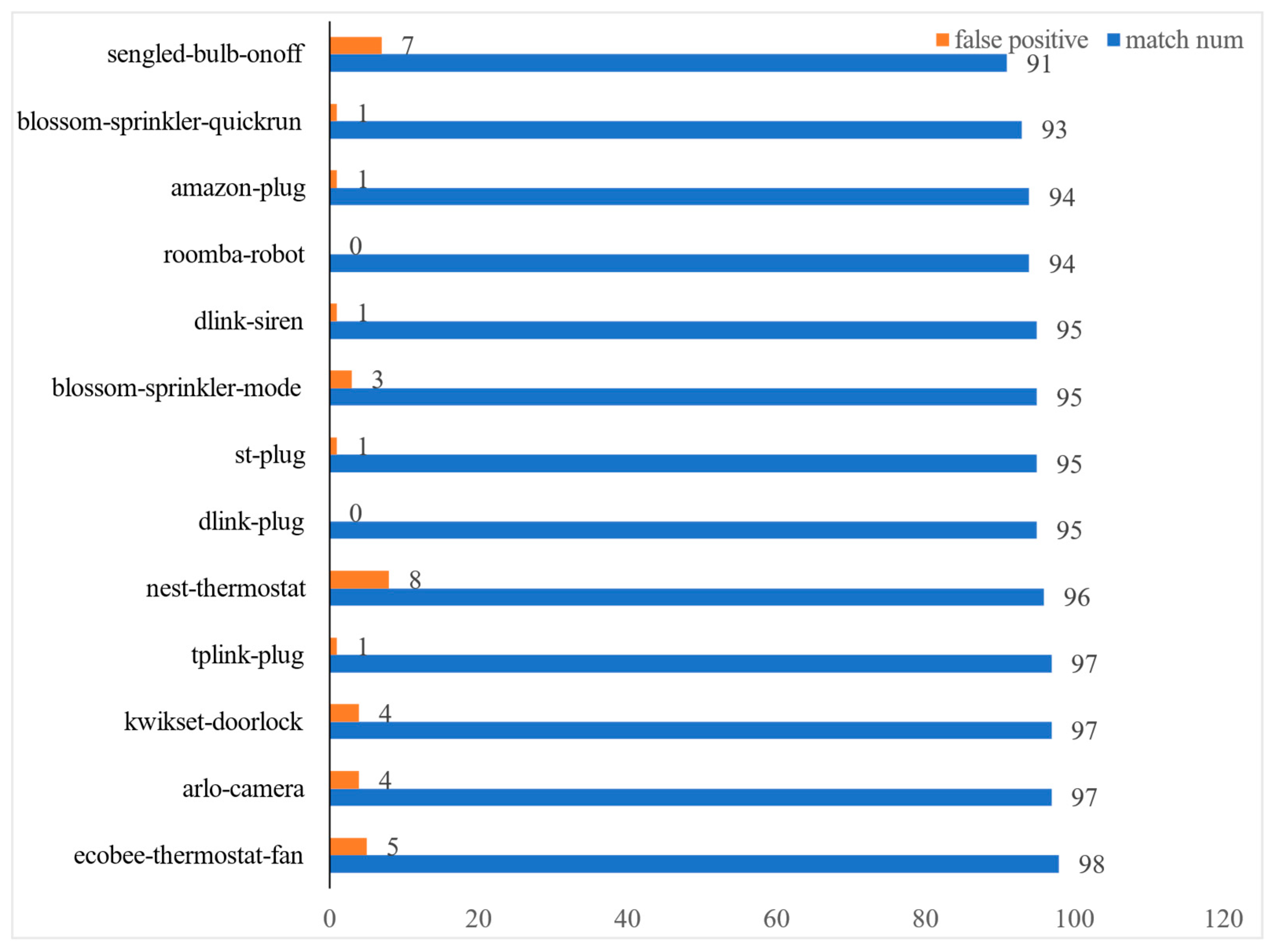
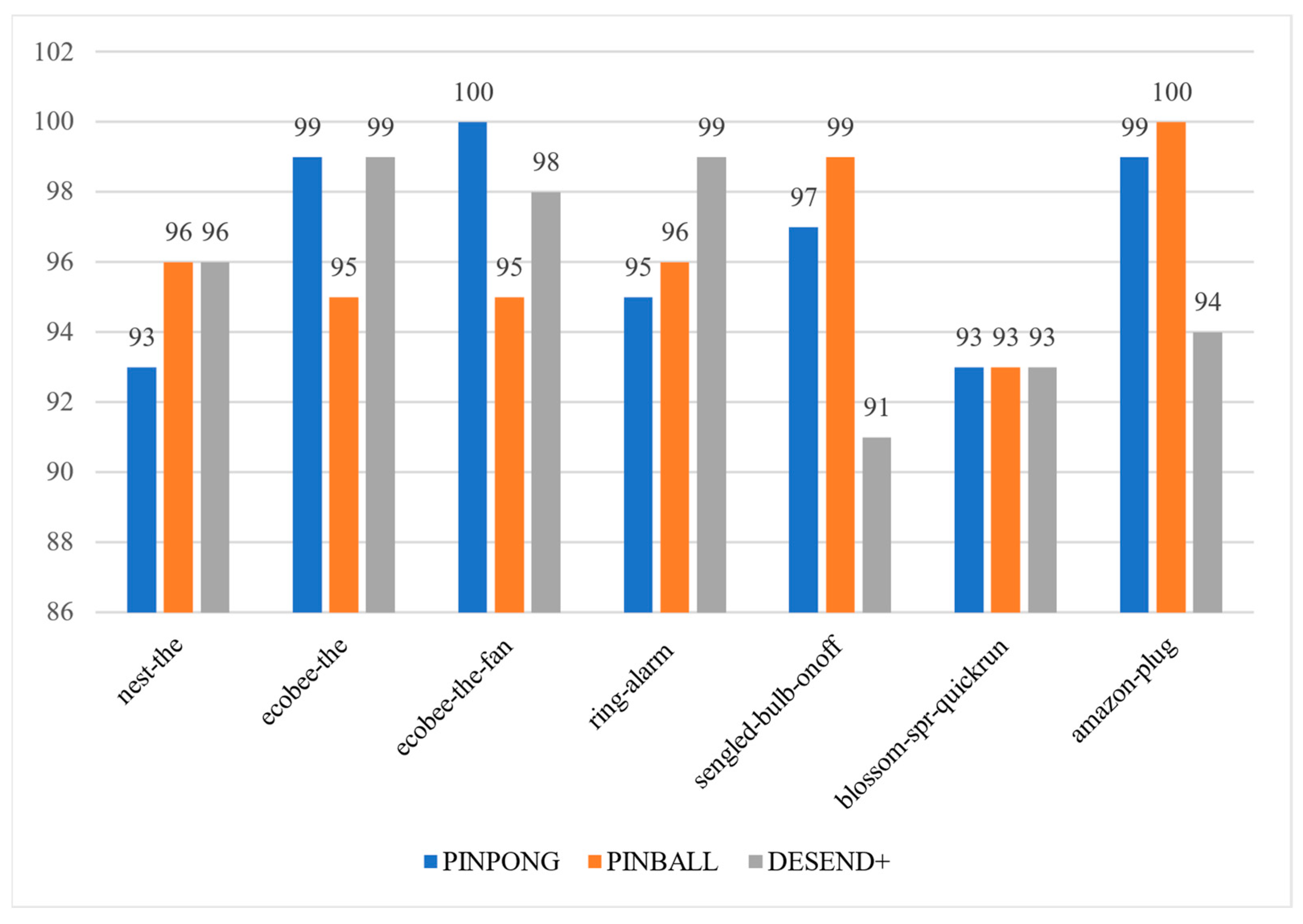
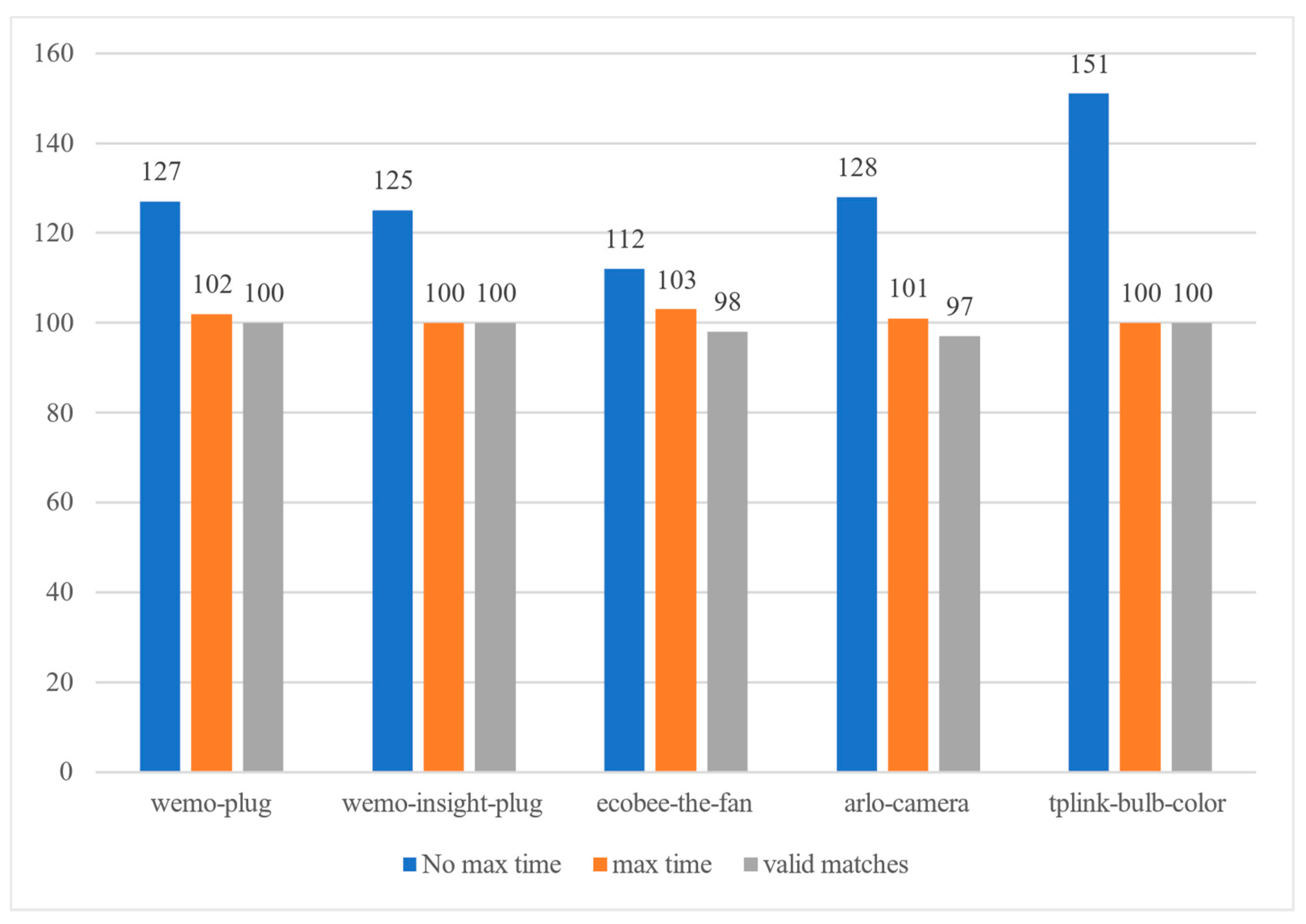
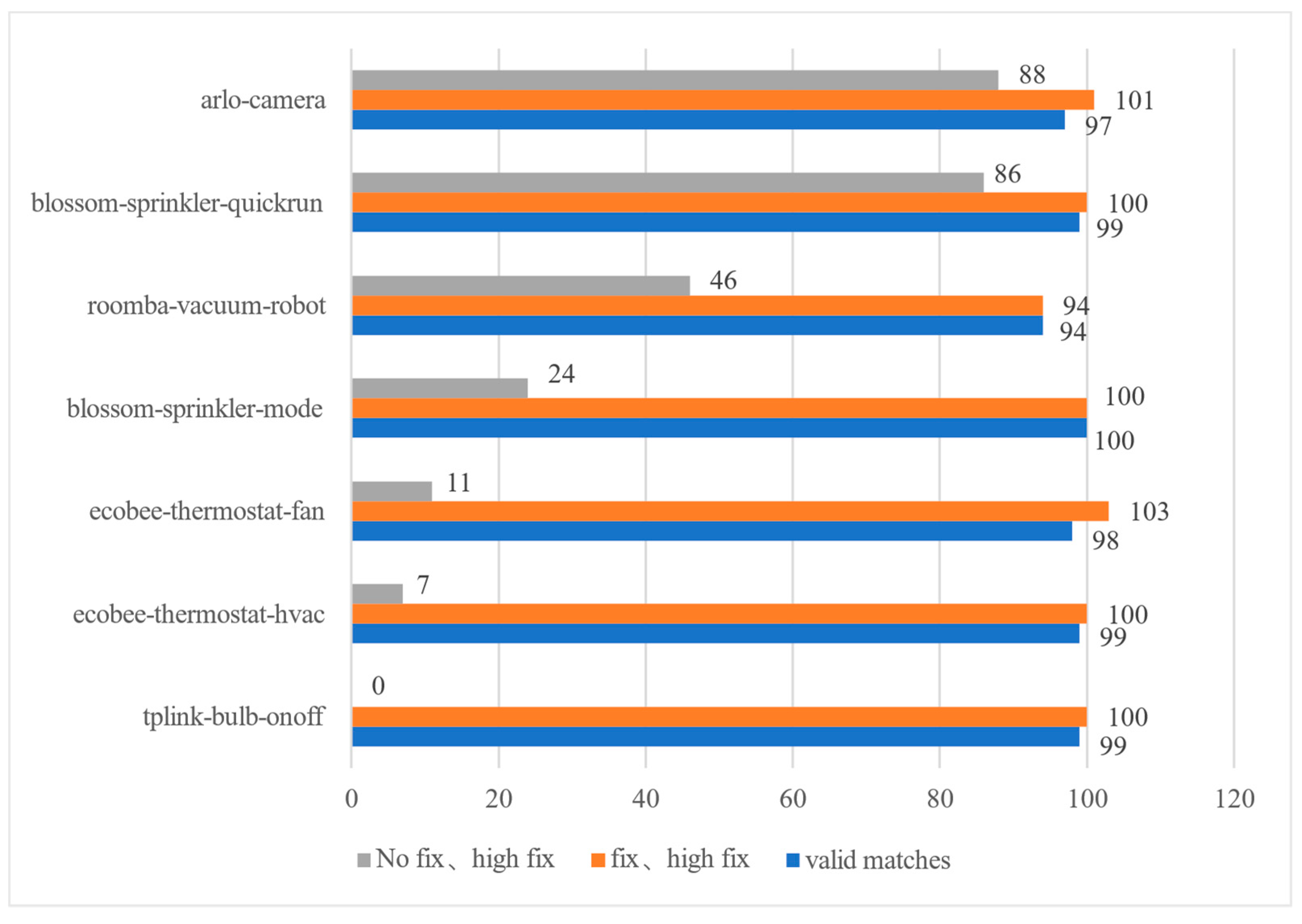
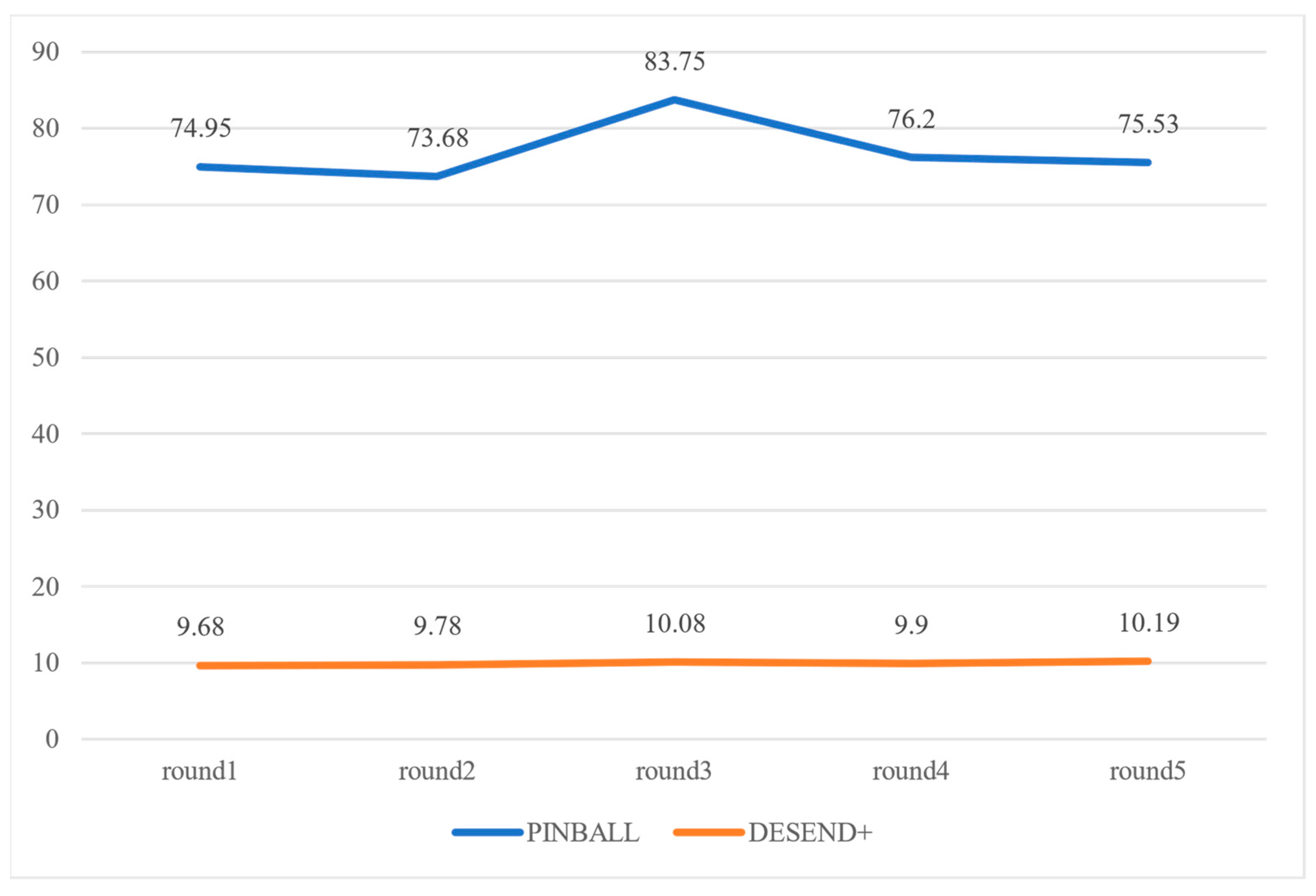
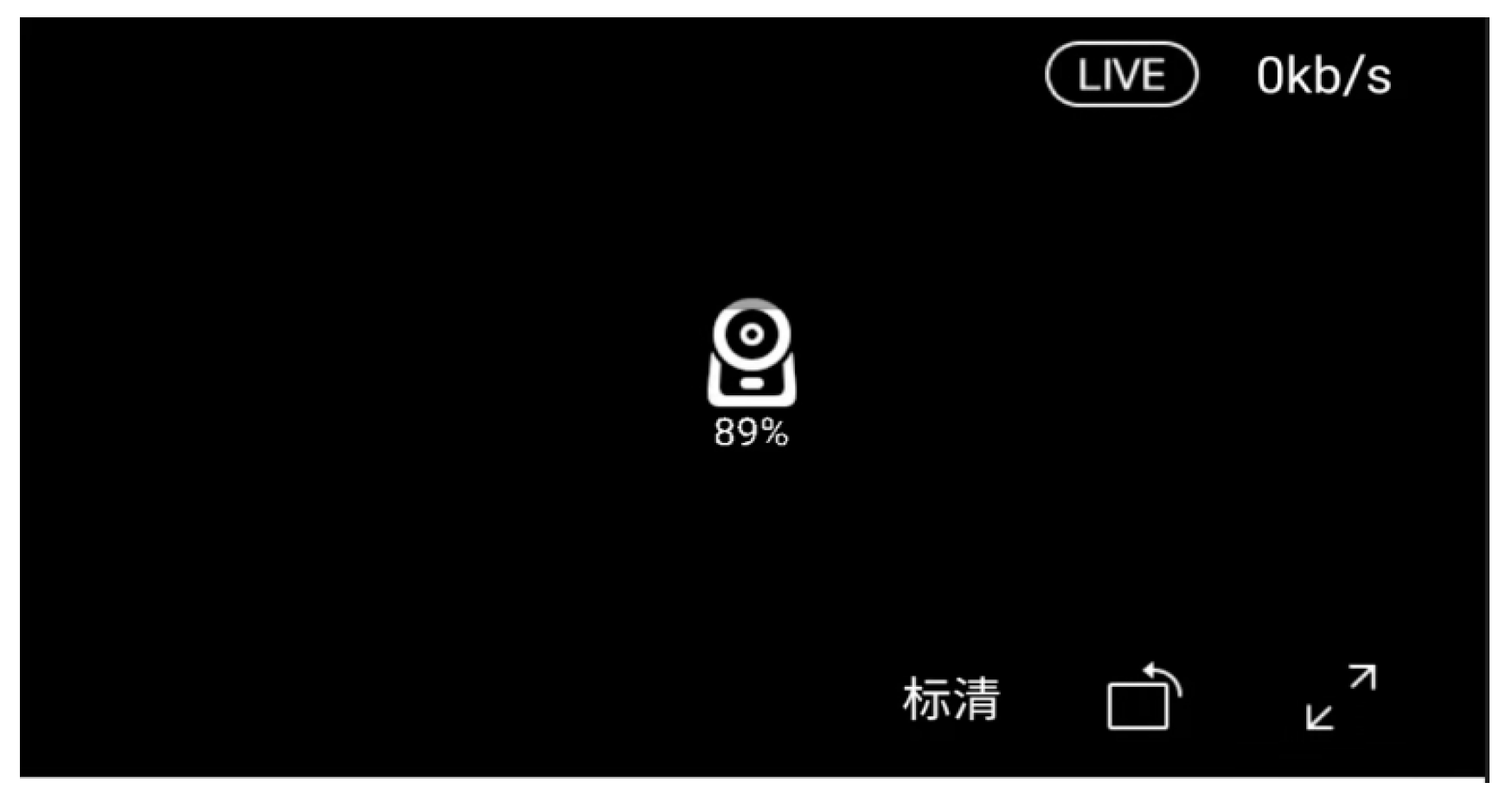

| Packet Size Contained in the Signature | |
|---|---|
| DESEND+ | key: (46,58,71,198,227,309,520,1049) high: (627,1311,1454) |
| PINGPONG | 198, 227 |
| Work | Feature | Protocol | Fast Detection | Events Control |
|---|---|---|---|---|
| HomeSnitch | complex | TCP | Yes | No |
| PINGPONG | simple, | TCP | Yes | No |
| PINBALL | simple | TCP, UDP | No | No |
| DESEND+ | simple | TCP, UDP | Yes | Yes |
| Component | Description |
|---|---|
| name | device event name |
| key | key-packet set |
| high | high-frequency-packet set |
| min | minimum number of occurrences in the set of high-frequency-packet set |
| max_time | maximum interval between two adjacent matching packets |
| fix | key-packet-set matching number adjustment value |
| high fix | High-frequency-packet set matching number adjustment value |
| Keyword | Description |
|---|---|
| manufacturer | device manufacturer |
| name | device name |
| version | File Version |
| event num | Number of device events |
| event list | Device event signature list |
| Device (Mac/IP) | Event | Signature | Action | ||
|---|---|---|---|---|---|
| Key | High | … | |||
| (allure-speaker) 192.168.1.7 | android_wan audio_ON | 83, 74, 338, 60, 267 | 343, 54 | … | deny |
| android_wan audio_OFF | 83, 74, 338, 267, 60 | - | … | ask | |
| (roku-tv) 192.168.1.9 | android_lan remote | 60, 97, 66, 74, 1514 | 80, 75, 378, 373, 192, 117, 519, 1396, 607, 208, 244, 214 | … | permit |
| android_wan remote | 74, 66 | 97, 1514, (85, 86) | … | deny | |
| (lightify-hub) 192.168.1.15 | android_lan_ ON | 260, 196, 235, 108 | 93 | … | permit |
| android_lan_ OFF | 260, 196, 235 | 93, 108 | … | permit | |
| Keyword | Description | |
|---|---|---|
| match field | rule_id | Rule id |
| Mac/IP | Device Mac/IP address | |
| device_event | ||
| start_time | Effective start time | |
| end_time | Effective end time | |
| action field | control action | Log/Drop |
| CPU | i5-8400 |
|---|---|
| ram | 8 GB |
| OpenWRT | 19.07 |
| dnsmasq | 2.8.5 |
| hostapd | v2.10-devel |
| Device | Event | Signature | Protocol |
|---|---|---|---|
| Lenovo-R1 camera | watch video | 52, 60, 104, 106, 125, 184, 234, 1488 | TCP |
| Xiaomi smart camera 2K | watch video | 38, 40, 56, 60, 64, 96, 1060 | UDP |
| EZVIZ-C2C camera | watch video | 52, 60, 72, 120, 1440 | TCP |
| Device | Event | Key | High | Min | Max Time |
|---|---|---|---|---|---|
| allure-speaker | android_wan audio_ON | 83, 74, 338, 60, 267 | 343, 54 | 1 | 41.26 |
| android_wan audio_OFF | 83, 74, 338, 267, 60 | - | 2 | 43.24 | |
| roku-tv | android_lan remote | 60, 97, 66, 74, 1514 | 80, 75, 378, 373, 192, 117, 519, 1396, 607, 208, 244, 214 | 12 | 18.19 |
| android_wan remote | 74, 66 | 97, 1514, (85, 86) | 3 | 30.53 | |
| lightify-hub | android_lan_ ON | 260, 196, 235, 108 | 93 | 1 | 13.58 |
| android_lan_ OFF | 260, 196, 235 | 93, 108 | 1 | 13.38 |
| Device Event | Fix (ON) | High Fix (ON) | Fix (OFF) | High Fix (OFF) |
|---|---|---|---|---|
| TP-LINK bulb | 1 | 0 | 1 | 0 |
| ecobee-thermostat-havc | 1 | 0 | 1 | 0 |
| ecobee-thermostat-fan | 1 | 0 | 1 | 0 |
| blossom-sprinkler-quickrun | 0 | 3 | 0 | 0 |
| blossom-sprinkler-mode | 0 | 1 | 1 | 0 |
| alro-camera | 0 | 1 | 0 | 1 |
| roomba-vacuum-robot | 1 | 0 | 1 | 0 |
| Value | |
|---|---|
| key | (246, 259, 430, 475) |
| high | () |
| min | 0 |
| max_time | 0.56366491317749023 |
| fix | 0 |
| high fix | 0 |
| Match Rate | False Positive Rate | Detection Time (s) | UDP Support | |
|---|---|---|---|---|
| PINBALL | 98.4% | 0.08% | 76.418 | yes |
| DESEND+ | 98.8% | 1.8% | 9.926 | yes |
| Device Event | Intercepted Packets | Result |
|---|---|---|
| Lenovo R1-View the video | 125, 184, 234, 1488 | unable to view video |
| Fluorite C2C-View the Video | 1440, 120, 72, 52(0), 60 | unable to view video |
| Fluorite C2C-View the Video | 52(1) | able to view video |
| Xiaomi smart camera 2K-View the Video | 96, 1060 | unable to view video |
| Xiaomi smart camera 2K-View the Video | 38, 40, 56, 60, 64 | able to view video |
| Method | Accuracy | Demand | Feature | |
|---|---|---|---|---|
| Machine learning classification | Supervised Learning | High | Precise traffic classification | High accuracy |
| Unsupervised Learning | Middle | Unknown traffic classification Traffic law extraction Feature validity evaluation | Identify unknown traffic | |
| Deep Learning | High | Precise traffic classification Automatic feature extraction | High accuracy, Unsupervised | |
| Statistical classification | High | Precise traffic classification | Well-designed methods could realize real-time classification | Statistical classification |
Publisher’s Note: MDPI stays neutral with regard to jurisdictional claims in published maps and institutional affiliations. |
© 2022 by the authors. Licensee MDPI, Basel, Switzerland. This article is an open access article distributed under the terms and conditions of the Creative Commons Attribution (CC BY) license (https://creativecommons.org/licenses/by/4.0/).
Share and Cite
Zhao, M.; Chen, J.; Yang, Z.; Liu, Y.; Zhang, S. HomeMonitor: An Enhanced Device Event Detection Method for Smart Home Environment. Sensors 2022, 22, 9389. https://doi.org/10.3390/s22239389
Zhao M, Chen J, Yang Z, Liu Y, Zhang S. HomeMonitor: An Enhanced Device Event Detection Method for Smart Home Environment. Sensors. 2022; 22(23):9389. https://doi.org/10.3390/s22239389
Chicago/Turabian StyleZhao, Meng, Jie Chen, Zhikai Yang, Yaping Liu, and Shuo Zhang. 2022. "HomeMonitor: An Enhanced Device Event Detection Method for Smart Home Environment" Sensors 22, no. 23: 9389. https://doi.org/10.3390/s22239389
APA StyleZhao, M., Chen, J., Yang, Z., Liu, Y., & Zhang, S. (2022). HomeMonitor: An Enhanced Device Event Detection Method for Smart Home Environment. Sensors, 22(23), 9389. https://doi.org/10.3390/s22239389





